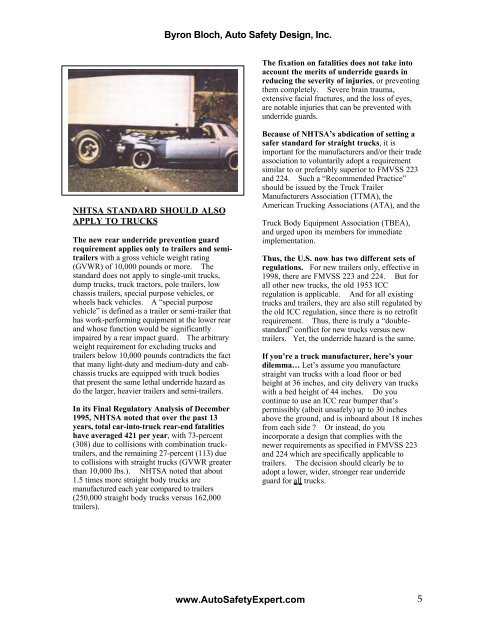Underride Protection
Formula 1 UNDERUN SAFETY A MUST
Formula 1 UNDERUN SAFETY A MUST
Create successful ePaper yourself
Turn your PDF publications into a flip-book with our unique Google optimized e-Paper software.
Byron Bloch, Auto Safety Design, Inc.<br />
The fixation on fatalities does not take into<br />
account the merits of underride guards in<br />
reducing the severity of injuries, or preventing<br />
them completely. Severe brain trauma,<br />
extensive facial fractures, and the loss of eyes,<br />
are notable injuries that can be prevented with<br />
underride guards.<br />
NHTSA STANDARD SHOULD ALSO<br />
APPLY TO TRUCKS<br />
The new rear underride prevention guard<br />
requirement applies only to trailers and semitrailers<br />
with a gross vehicle weight rating<br />
(GVWR) of 10,000 pounds or more. The<br />
standard does not apply to single-unit trucks,<br />
dump trucks, truck tractors, pole trailers, low<br />
chassis trailers, special purpose vehicles, or<br />
wheels back vehicles. A “special purpose<br />
vehicle” is defined as a trailer or semi-trailer that<br />
has work-performing equipment at the lower rear<br />
and whose function would be significantly<br />
impaired by a rear impact guard. The arbitrary<br />
weight requirement for excluding trucks and<br />
trailers below 10,000 pounds contradicts the fact<br />
that many light-duty and medium-duty and cabchassis<br />
trucks are equipped with truck bodies<br />
that present the same lethal underride hazard as<br />
do the larger, heavier trailers and semi-trailers.<br />
In its Final Regulatory Analysis of December<br />
1995, NHTSA noted that over the past 13<br />
years, total car-into-truck rear-end fatalities<br />
have averaged 421 per year, with 73-percent<br />
(308) due to collisions with combination trucktrailers,<br />
and the remaining 27-percent (113) due<br />
to collisions with straight trucks (GVWR greater<br />
than 10,000 lbs.). NHTSA noted that about<br />
1.5 times more straight body trucks are<br />
manufactured each year compared to trailers<br />
(250,000 straight body trucks versus 162,000<br />
trailers).<br />
Because of NHTSA’s abdication of setting a<br />
safer standard for straight trucks, it is<br />
important for the manufacturers and/or their trade<br />
association to voluntarily adopt a requirement<br />
similar to or preferably superior to FMVSS 223<br />
and 224. Such a “Recommended Practice”<br />
should be issued by the Truck Trailer<br />
Manufacturers Association (TTMA), the<br />
American Trucking Associations (ATA), and the<br />
Truck Body Equipment Association (TBEA),<br />
and urged upon its members for immediate<br />
implementation.<br />
Thus, the U.S. now has two different sets of<br />
regulations. For new trailers only, effective in<br />
1998, there are FMVSS 223 and 224. But for<br />
all other new trucks, the old 1953 ICC<br />
regulation is applicable. And for all existing<br />
trucks and trailers, they are also still regulated by<br />
the old ICC regulation, since there is no retrofit<br />
requirement. Thus, there is truly a “doublestandard”<br />
conflict for new trucks versus new<br />
trailers. Yet, the underride hazard is the same.<br />
If you’re a truck manufacturer, here’s your<br />
dilemma… Let’s assume you manufacture<br />
straight van trucks with a load floor or bed<br />
height at 36 inches, and city delivery van trucks<br />
with a bed height of 44 inches. Do you<br />
continue to use an ICC rear bumper that’s<br />
permissibly (albeit unsafely) up to 30 inches<br />
above the ground, and is inboard about 18 inches<br />
from each side ? Or instead, do you<br />
incorporate a design that complies with the<br />
newer requirements as specified in FMVSS 223<br />
and 224 which are specifically applicable to<br />
trailers. The decision should clearly be to<br />
adopt a lower, wider, stronger rear underride<br />
guard for all trucks.<br />
www.AutoSafetyExpert.com 5


